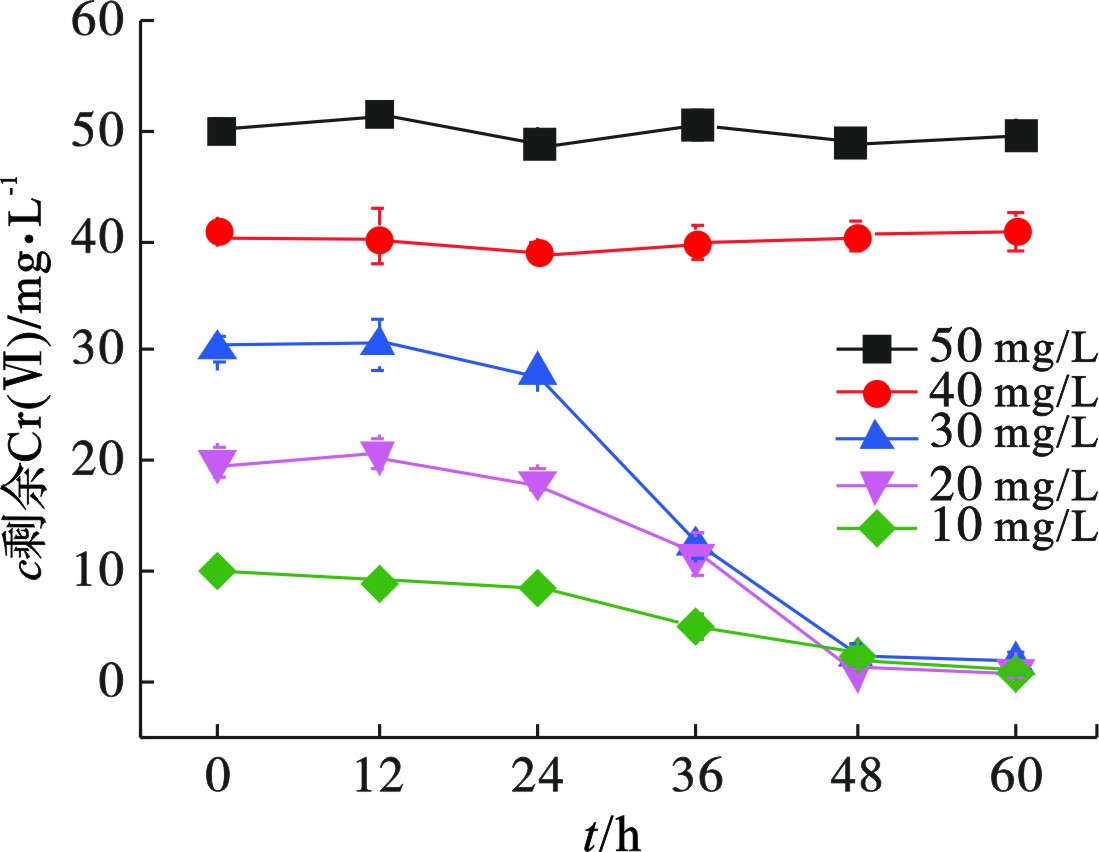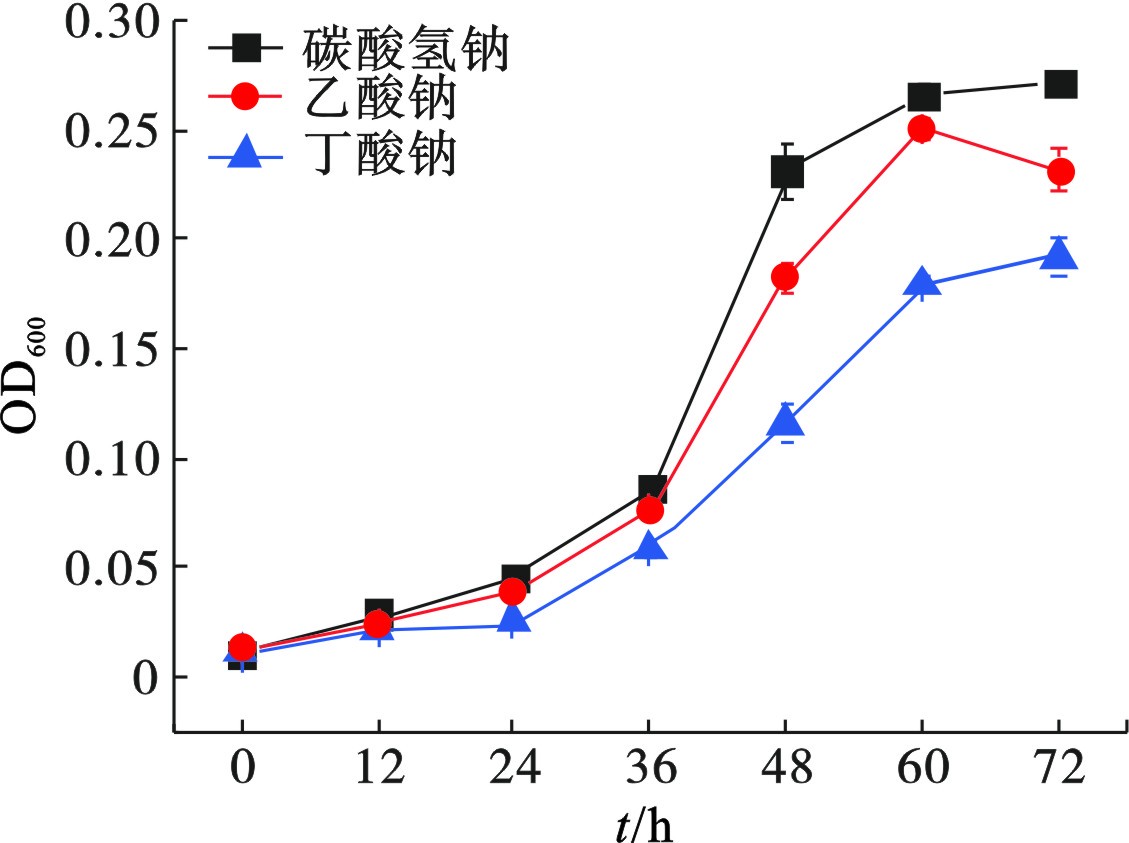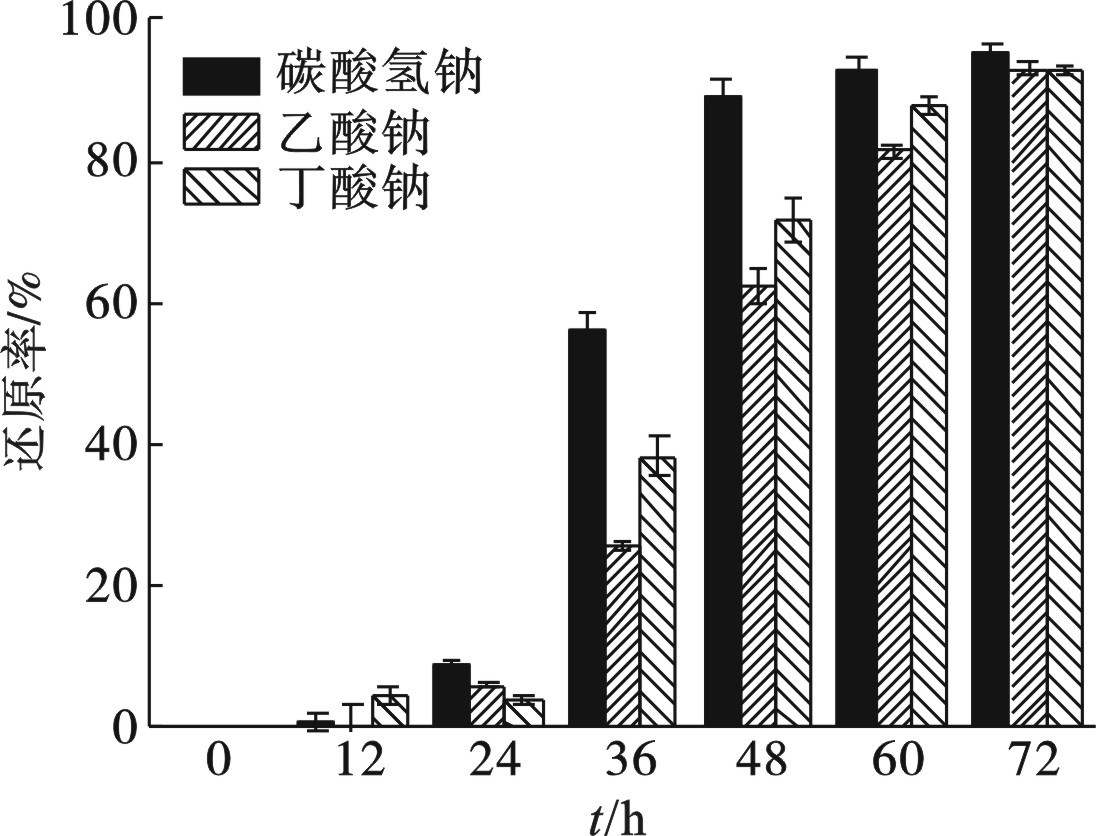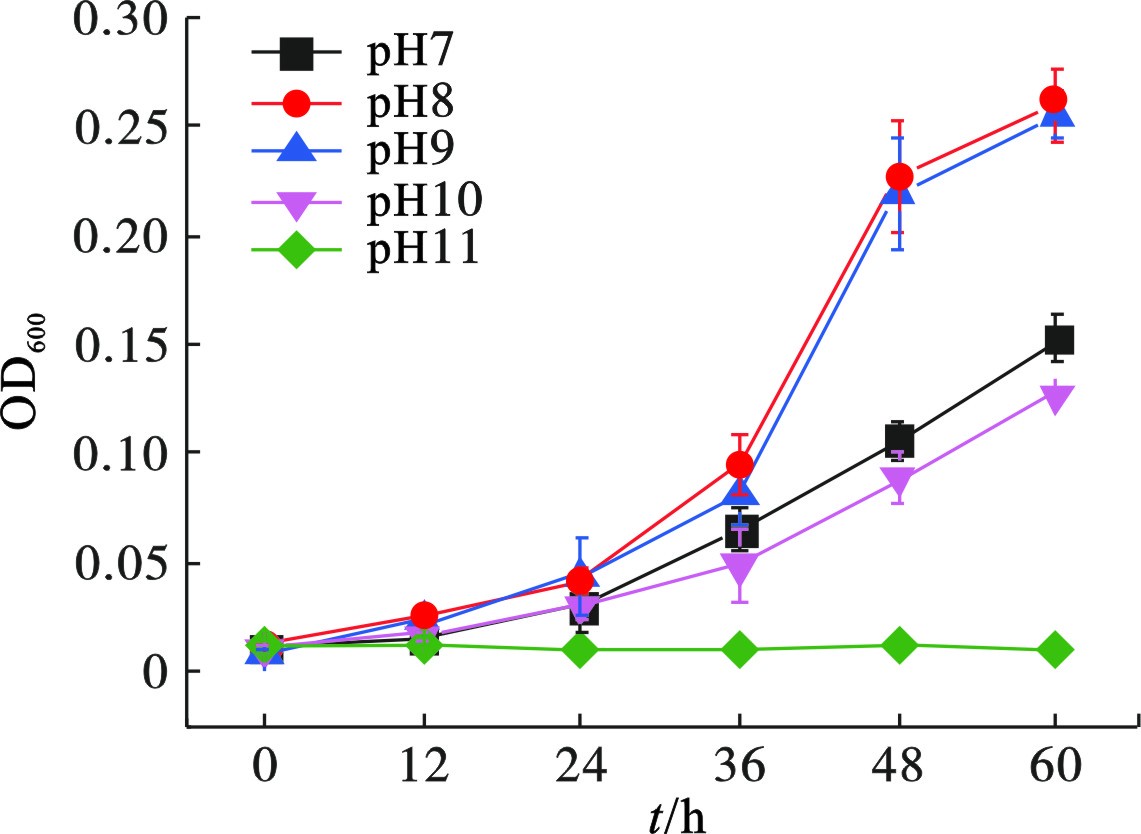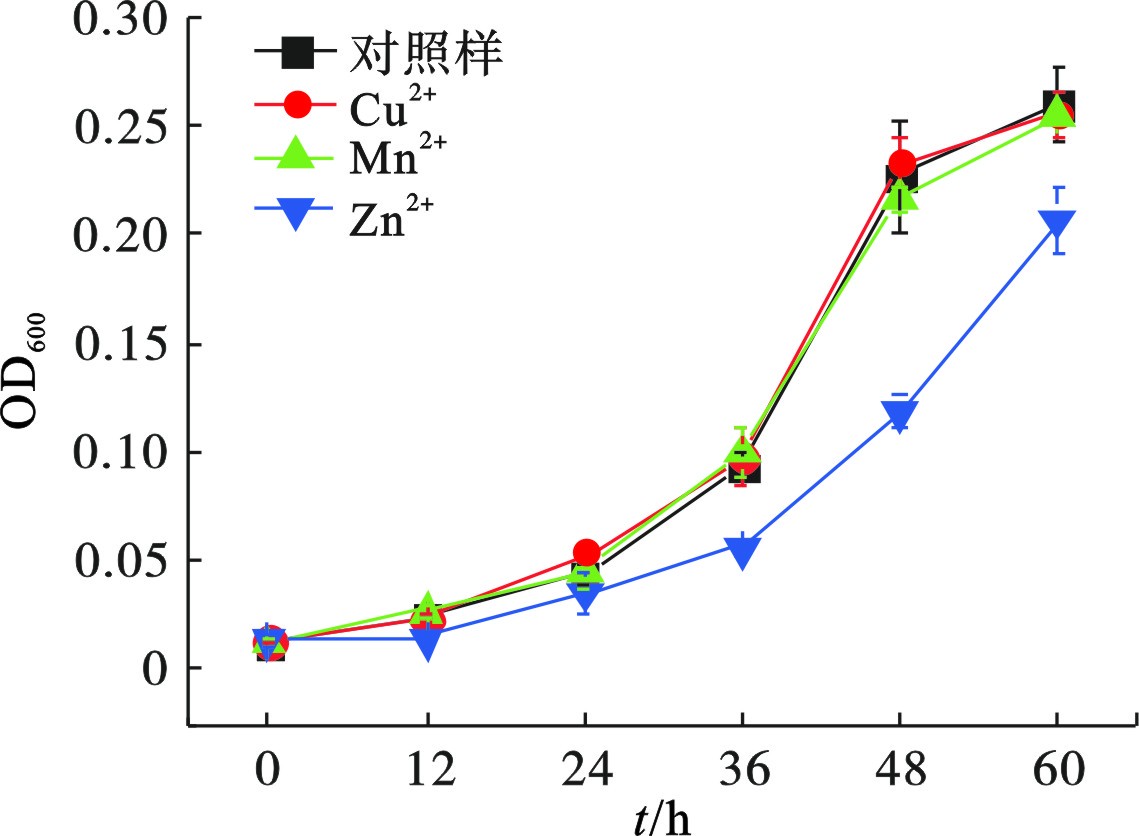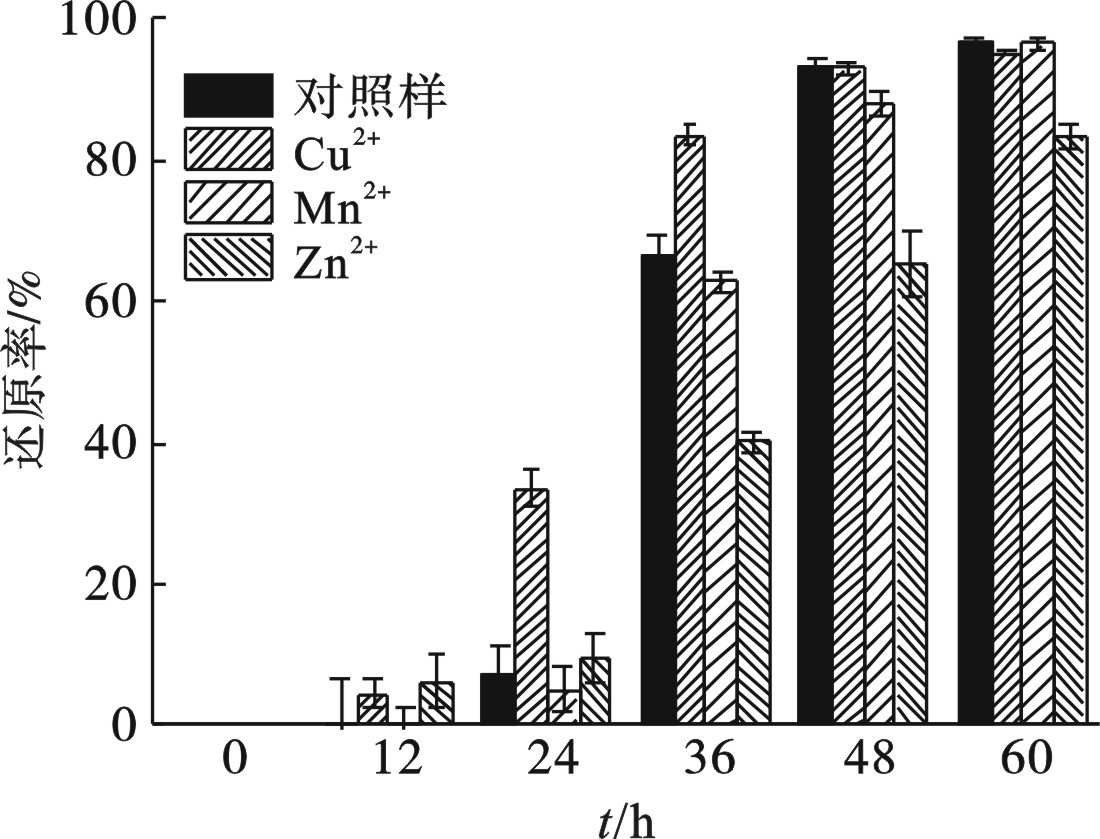-
铬作为一种重要的金属原料,在冶金、化工、皮革和制药等行业中广泛使用[1-2],但是,如果处置不当,会随废弃物进入自然环境,造成污染。环境中常见的是Cr(Ⅲ)和Cr(Ⅵ),以Cr3+、CrO2−、CrO42-和Cr2O72-这4种形态存在[3]。其中,Cr(Ⅲ)是人体和动植物的必需微量元素,而Cr(Ⅵ)则会对人体产生严重毒害,毒性是Cr(Ⅲ)的100倍左右,对人体皮肤、呼吸道和眼睛等器官存在危害,摄入过量会导致肾衰竭及癌症,即使在μg级仍具有毒性[3-5]。因此,《地表水环境质量标准:GB 3838—2002》[6]严格限定可作饮用水源的Ⅲ类水中Cr(Ⅵ)浓度不得高于0.05 mg/L。
含铬废水的处置方法主要包括:物理法、化学法、物化法和生物法等。其中,生物法处理是通过微生物的生长代谢将可溶的Cr(Ⅵ)转化为低毒或无毒的Cr(Ⅲ)[7-8],虽然效率低于物理和化学方法,但是具有成本低和无二次污染风险等优点,成为低含量Cr(Ⅵ)污染环境的主要修复方法之一。
异化金属还原菌(Dissimilatory Metal Reduction Bacteria,DMRB)是一种能够以金属氧化物作为电子受体,并且通过还原金属氧化物获得能量的细菌[9]。其还原机理主要有3种:(1)借助电子传递中间体复合物进行电子传递[10];(2)与金属氧化物表面接触直接传递电子[11];(3)借助金属螯合剂溶解金属离子螯合物后再还原[12-13]。Geobacter metallireducens是最早被发现的DMRB,能够以Fe(Ⅲ)为唯一电子受体将有机物氧化为CO2[14]。随着研究的深入,DMRB也被发现具有重金属污染处置能力。文献[15-16]研究发现,Shewanella oneidensis和Bacillus anthracis可以分别将V(V)和Cr(Ⅵ)还原为V(IV)和Cr(Ⅲ)。牛永艳等[17] 将Cr(Ⅵ)还原菌Cellulosimicrobium cellilans应用在微生物燃料电池处理含铬废水的研究中,Cr(Ⅵ)还原率达到68.9%。魏蓝[18]利用芽孢杆菌属细菌修复Cr(Ⅵ)污染土壤,还原率达到87.7%。DMRB对重金属的还原作用为环境中重金属的处置和无害化提供了新思路。
本研究以1株耐盐碱的异化金属菌Tindallia magadiensis为研究对象,考察了初始Cr(Ⅵ)浓度、初始pH和碳源等条件对菌株生长和Cr(Ⅵ)还原的影响,探讨了共存金属离子对菌株的扰动作用,获得了该菌的最佳生长条件和Cr(Ⅵ)还原效率。该菌株自1996年分离至今,只进行过系统发育分析,从未开展环境功能性探究,本研究为高盐碱极端环境下铬污染的处理提供新的探索方向。
-
实验菌株Tindallia magadiensis Z-7934T购自德国微生物菌种保藏中心 (Deutsche Sammlung von Mikroorganismen und Zellkulturen )。该菌于1996年从肯尼亚马加迪湖的苏打沉积物中分离,其后仅进行了系统发育进化研究,为该菌属的模式菌株[13]。该菌为G+的嗜碱专性厌氧菌,可以在pH 7.5~10.5和高Na+环境中生长。
培养基组成为:蛋白胨5 g/L,NaHCO3 40 g/L,KH2PO4 0.3 g/L,NH4Cl 0.5 g/L。50 mL培养基分装入100 mL厌氧瓶中,通入高纯Ar气排除残留的O2,胶塞密封,121 ℃灭菌10 min备用。按照5%比例接种,35 ℃摇床震荡培养。
-
高浓度的Cr(Ⅵ)对生物具有严重的毒害作用,为了探讨T. magadiensis对Cr(Ⅵ)的还原能力,首先要获得其对Cr(Ⅵ)的耐受性。初始Cr(Ⅵ)浓度分别设定为10、20、30、40和50 mg/L,以5%接种量接种对数期种子液,每组设3个平行。35 ℃,120 r/min恒温振荡培养。每12 h取样,测定细胞生物量和Cr(Ⅵ)的浓度。
-
采用常用的3种碳源考察对T. magadiensis生长和Cr(Ⅵ)还原的影响。保持初始碳源物质的量相同,碳酸氢钠、丁酸钠和乙酸钠分别为40、13.08和32.35 g/L,选择最适Cr(Ⅵ)浓度,初始pH保持与碳酸氢钠组一致。实验条件和测试指标与前一组实验相同。
-
探讨初始pH对菌株还原Cr(Ⅵ)的影响。以5%接种对数期种子液至适宜初始Cr(Ⅵ)浓度,初始pH分别为7~11的培养基当中。实验条件和测试指标与第一组实验相同。
-
选取环境中常见与Cr共存的Zn2+、Mn2+和Cu2+探讨共存金属离子对菌株还原Cr(Ⅵ)的影响。以5%接种对数期种子液至适宜初始Cr(Ⅵ)浓度和pH的培养基中,探讨分别投加0.5 mmol/L的Cu2+、Mn2+或Zn2+对菌株还原Cr(Ⅵ)的影响,以未添加其他金属离子的培养基作为对照。实验条件和测试指标与第一组实验相同。
-
溶液中总铬和Cr(Ⅵ)的含量分别参照《水质总铬的测定二苯碳酰二肼分光光度法:GBT 7466—1987》和《水质Cr(Ⅵ)的测定二苯碳酰二肼分光广度法:GB 7467—87》测定[6]。细胞生物量使用分光光度计UVmini-1240(日本岛津)以OD600计算。pH使用S220型pH计(Mettler Toledo,Switzerland)测定。
-
Cr(Ⅵ)对微生物的生长有显著影响,过高浓度会直接杀死细菌。初始Cr(Ⅵ)浓度对菌株Z-7934生长的影响,见图1。
Cr(Ⅵ)浓度高于40 mg/L时,菌株Z-7934无法存活,未检测到细胞生物量。初始Cr(Ⅵ)浓度为10、20和30 mg/L时,经60 h培养的细胞生物量(OD600)分别为0.29、0.28和0.27,说明菌株Z-7934可以在Cr(Ⅵ)浓度低于40 mg/L时生长。
菌株Z-7934对不同初始浓度Cr(Ⅵ)的还原,见图2。
初始Cr(Ⅵ)浓度高于40 mg/L时,细菌无法生长,Cr(Ⅵ)未被还原。Cr(Ⅵ)浓度为10~30 mg/L时,培养前24 h,细胞量较少,Cr(Ⅵ)还原量较低,剩余量分别为9.03、18.26 和28.03 mg/L。随着培养时间的延长,生物量增加,还原率提升。在第60 h,菌株对Cr(Ⅵ)的还原量分别为9.1、19.07和28.24 mg/L,说明菌株Z-7934在可耐受的Cr(Ⅵ)浓度范围内具有很好的还原性。初始Cr(Ⅵ)浓度为30 mg/L 时,还原率可达94.13%,还原速率达到每小时0.47 mg/L。
-
不同碳源对菌株Z-7934生长的影响,见图3。
菌株在前24 h生长较慢,在碳酸氢钠、乙酸钠或丁酸钠为碳源的培养基中,生物量(OD600)分别为0.04、0.04和0.02。随着培养时间的延长,在第36 h后生长明显提升,第48 h时,菌株的生物量(OD600)分别达到0.23、0.18和0.13,菌株Z-7934更适宜以碳酸氢钠为碳源生长。
碳源对菌株Z-7934还原Cr(Ⅵ)的影响,见图4。
以碳酸氢钠为碳源时,菌株对Cr(Ⅵ)的还原速率最快。在第24 h,菌株在碳酸氢钠、乙酸钠和丁酸钠的培养基中对Cr(Ⅵ)的还原率分别为8.90%、6.20%和3.23%。随着时间和生物量的变化,在第48 h,菌株在3种碳源的培养基中对Cr(Ⅵ)的还原率分别为89.05%、63.33%和71.72%,以碳酸氢钠为碳源时,菌株对Cr(Ⅵ)的还原速率最快。在第60 h,菌株在3种碳源的培养基中的Cr(Ⅵ)还原率分别达到95.13%、93.13%和93.06%,此时接近还原终点,三者还原率基本相同。
实验结果表明生物量与Cr(Ⅵ)的还原速率成正相关。36~48 h是菌株Z-7934快速生长阶段,Cr(Ⅵ)的还原速率也明显提升。以碳酸氢钠作为碳源可以更好地促进菌株Z-7934对Cr(Ⅵ)的还原,以实现能量的传递,供给自身的繁殖与生长。因此,相比有机小分子碳源,无机碳源碳酸氢钠对菌株Z-7934的生长和金属异化过程更为有利。
-
菌株Z-7934在初始pH 8~9的偏碱性条件生长较好,明显优于初始pH 7或pH 10时,见图5,但是无法耐受高于pH 11。在第60 h,菌株Z-7934在初始pH为7、8、9和10的培养基中,生物量(OD600)分别为0.15、0.26、0.25和0.13。
初始pH对菌株Z-7934还原Cr(Ⅵ)的影响,见图6。
在最初的24 h,生物量和Cr(Ⅵ)的还原率均较低。随着生物量的大幅提升,Cr(Ⅵ)的还原率也随之增长。第48 h时,初始pH 8和9的培养基中,Cr(Ⅵ)的还原率分别达到92.56%和89.81%,并在第60 h时分别达到96.89%和94.91%;而初始pH 10的培养基中Cr(Ⅵ)的还原率最低,仅为87.02%。
菌株Z-7934在初始pH 7~10时,均能生长并实现Cr(Ⅵ)的还原,在pH 8~9时具有更高的还原效率,说明该菌株耐碱性较好,可以实现碱性条件下的重金属异化还原。
-
共存金属离子对菌株Z-7934生长的影响差异明显,见图7。
在添加少量Cu2+和Mn2+的培养基中,菌株Z-7934的生长与对照组并无差异,但是受到Zn2+的影响显著。在36 h时,菌株Z-7934在添加Cu2+、Mn2+和Zn2+的培养基中,生物量(OD600)分别为0.10、0.10和0.06;在60 h时,生物量(OD600)分别为0.26、0.26和0.21。
共存金属离子对菌株Z-7934还原Cr(Ⅵ)的影响,见图8。
实验结果表明,Mn2+共存对菌株Z-7934还原Cr(Ⅵ)没有显著影响。而Zn2+会抑制菌株生长,影响对Cr(Ⅵ)的还原。少量的Cu2+对菌株生长影响很小,却提升了其对Cr(Ⅵ)的还原速率。Cu2+对菌株生长和还原Cr(Ⅵ)的影响并不相同,推断原因有2种:(1)铜是微生物必需的微量元素,可能是某些还原性功能酶辅基的组成原子,在微量Cu2+的存在下,激活了与还原Cr(Ⅵ)相关酶的活性,促进了其对Cr(Ⅵ)的还原;(2)Cu2+在T. magadiensis的电子传递过程中起着一定的作用,可以辅助还原Cr(Ⅵ)进行能量代谢[19]。由于T. magadiensis被分离后,没有进行过相关代谢的研究,而其生境和生长代谢存在一定的特殊性,对其环境功能性的研究可能有一些新的发现。
添加少量的Zn2+对菌株还原Cr(Ⅵ)有抑制作用,第60 h时总还原率为83.54%,明显低于另外3组。添加Mn2+对Cr(Ⅵ)的还原影响较小,第24 h时,对照组和Mn2+实验组中Cr(Ⅵ)的还原率分别为7.11%和5.07%;第36 h时,还原率分别增长至66.46%和62.79%。添加少量Cu2+对菌株Z-7934还原Cr(Ⅵ)有促进作用,在24~36 h,对Cr(Ⅵ)的还原速率较其余3组具有明显优势,第24和第36 h时还原率分别达到33.41%和83.41%。第60 h时,由于接近还原终点,除添加Zn2+的实验组外,Cr(Ⅵ)的还原率均在95%左右,对照组、Cu2+和Mn2+实验组的Cr(Ⅵ)还原率分别为96.57%、95.06%和96.39%。
-
碱性异化金属还原菌Tindallia magadiensis可以在厌氧条件下还原少量Cr(Ⅵ),转化为Cr(Ⅲ),实现铬的减毒。在少量Cr(Ⅵ)浓度(30 mg/L),碱性条件(初始pH 8),无机碳源(NaHCO3)条件下,获得最高Cr(Ⅵ)还原率96.89%。在少量Cu2+共存时,可以加快Cr(Ⅵ)的还原。细菌T. magadiensis作为碱性厌氧环境条件下一定浓度Cr(Ⅵ)减毒的新选择,具有一定的应用潜质。
碱性异化金属还原菌T. magadiensis对Cr(Ⅵ)的还原研究
Reduction of Cr(Ⅵ) by an alkaline dissimilative metal reduction bacterium of T. magadiensis
-
摘要: 铬(Cr)作为一种环境中常见的重金属污染物,可以通过还原作用,从Cr(Ⅵ)降低价态至Cr(Ⅲ),实现减毒。该研究探讨了碱性厌氧异化金属还原菌Tindallia magadiensis对模拟含铬废水的减毒能力,分别研究了初始Cr(Ⅵ)浓度、碳源、初始pH和共存金属离子对其生长和Cr(Ⅵ)还原能力的影响。结果表明:该菌具有较好的Cr(Ⅵ)耐受能力,可在初始Cr(Ⅵ)浓度30 mg/L、pH 8、NaHCO3为碳源时,实现96.9%的Cr(Ⅵ)还原;微量Cu2+的存在还可以进一步促进对Cr(Ⅵ)的还原;T. magadiensis为碱性环境中少量Cr(Ⅵ)的微生物减毒提供了新的研究思路和菌种选择。
-
关键词:
- Cr(Ⅵ)还原 /
- 异化金属还原菌 /
- Tindallia magadiensis /
- 碱性厌氧 /
- 共存金属离子
Abstract: As a common environmental heavy metal pollutant, the toxicity attenuation of chromium (Cr) can be archived by valence state reducing from Cr(Ⅵ) to Cr(Ⅲ). In this study, the attenuation ability of an alkaline anaerobic dissimilative metal-reducing bacterium of Tindallia magadiensis was investigated in the simulated chromium-containing wastewater. Effects of initial Cr(Ⅵ) concentration, carbon source, initial pH and coexisting metal ions on its growth and Cr(Ⅵ) reduction ability were studied. The experimental results indicated that the bacterium had a good Cr(Ⅵ) tolerance, and a 96.9% Cr(Ⅵ) reduction was achieved with the initial Cr(Ⅵ) concentration of 30 mg/L, pH of 8, and NaHCO3 as the carbon source. The presence of trace Cu2+ had a promotion on the reduction of Cr(Ⅵ). The reduction of Cr(Ⅵ) by T. magadiensis provided a new research idea and an alternative way for the microbial attenuation of small amount of Cr(Ⅵ) in the alkaline environment. -

-
[1] JOBBY R, JHA P, YADAV A K, et al. Biosorption and biotransformation of hexavalent chromium [Cr(Ⅵ)]: A comprehensive review[J]. Chemosphere, 2018, 207(SEP.): 255 − 266. [2] LI Z , MA Z , KUIJP T J V D , et al. A review of soil heavy metal pollution from mines in China: Pollution and health risk assessment[J]. Science of the Total Environment, 2014, s 468-469: 843 − 853. [3] 赵堃, 柴立元, 王云燕, 等. 水环境中铬的存在形态及迁移转化规律[J]. 工业安全与环保, 2006(8): 1 − 3. [4] 徐衍忠, 秦绪娜, 刘祥红, 等. 铬污染及其生态效应[J]. 环境科学与技术, 2002(增1): 8 − 9. [5] 王谦, 李延, 孙平, 等. 含铬废水处理技术及研究进展[J]. 环境科学与技术, 2013, 36(增2): 150 − 156. [6] 国家环境保护总局, 国家质量监督检验检疫总局. 地表水环境质量标准: GB 3838—2002 [S/OL]. (2006-10-27)[2020-10-20]. http://www.mee.gov.cn/ywgz/fgbz/bz/bzwb/shjbh/shjzlbz/200206/W020061027509896672057.pdf. [7] 刘婉, 李泽琴. 水中铬污染治理的研究进展[J]. 广东微量元素科学, 2007(9): 5 − 9. [8] 江澜. 微生物治理铬污染的应用与发展[J]. 重庆工商大学学报(自然科学版), 2006(2): 132 − 135. [9] 刘丽红, 谢桂琴, 王晓萍. 异化金属还原菌及其应用[J]. 哈尔滨师范大学自然科学学报, 2008(3): 81 − 84. [10] KEVBRIN V V, ZHILINA T N, RAINEY F A, et al. Tindallia magadii gen. nov. sp. nov. : An alkaliphilic anaerobic ammonifier from soda lake deposits[J]. Current Microbiology, 1998, 37(2): 94 − 100. doi: 10.1007/s002849900345 [11] CHILDERS S E, CIUFO S, LOVLEY D R. Geobacter metallireducens accesses insoluble Fe(Ⅲ) oxide by chemotaxis[J]. Nature, 2002, 416(6882): 767 − 769. doi: 10.1038/416767a [12] LOVLEY D R, FRAGA J L, BLUNT-HARRIS E L, et al. Humic substances as a mediator for microbially catalyzed metal reduction[J]. Acta Hydrochimica et Hydrobiologica, 2010, 26(3): 152 − 157. [13] NEVIN K P, LOVLEY D R. Mechanisms for accessing insoluble Fe(Ⅲ) oxide during dissimilatory Fe(Ⅲ) reduction by geothrix fermentans[J]. Appl Environ Microbiol, 2002, 68(5): 2294 − 2299. doi: 10.1128/AEM.68.5.2294-2299.2002 [14] VALI H, WEISS B, LI Y L, et al. Formation of tabular single-domain magnetite induced by Geobacter metallireducens GS-15[J]. Proceedings of the National Academy of Sciences, 2004, 101(46): 16121 − 16126. doi: 10.1073/pnas.0404040101 [15] 汪明霞, 王娟, 司友斌. Shewanella oneidensis MR-1异化还原Fe(Ⅲ)介导的As(Ⅲ)氧化转化[J]. 中国环境科学, 2014, 34(9): 2368 − 2373. [16] 徐卫华. 微生物还原Cr(Ⅵ)的特性与机理研究[D]. 长沙: 湖南大学, 2007. [17] 牛永艳, 陈正军, 赵帅, 等. 铬还原菌的分离筛选及其在微生物燃料电池生物阴极中的应用[J]. 微生物学通报, 2017, 44(7): 1631 − 1638. [18] 魏蓝. 土壤微生物对六价铬的还原及稳定化效果研究[D]. 苏州: 苏州科技大学, 2017. [19] ABE F, MIURA T, NAGAHAMA T, et al. Isolation of a highly copper-tolerant yeast, Cryptococcus sp. from the Japan Trench and the induction of superoxide dismutase activity by Cu2+[J]. Biotechnology Letters, 2001, 23(24): 2027 − 2034. doi: 10.1023/A:1013739232093 -



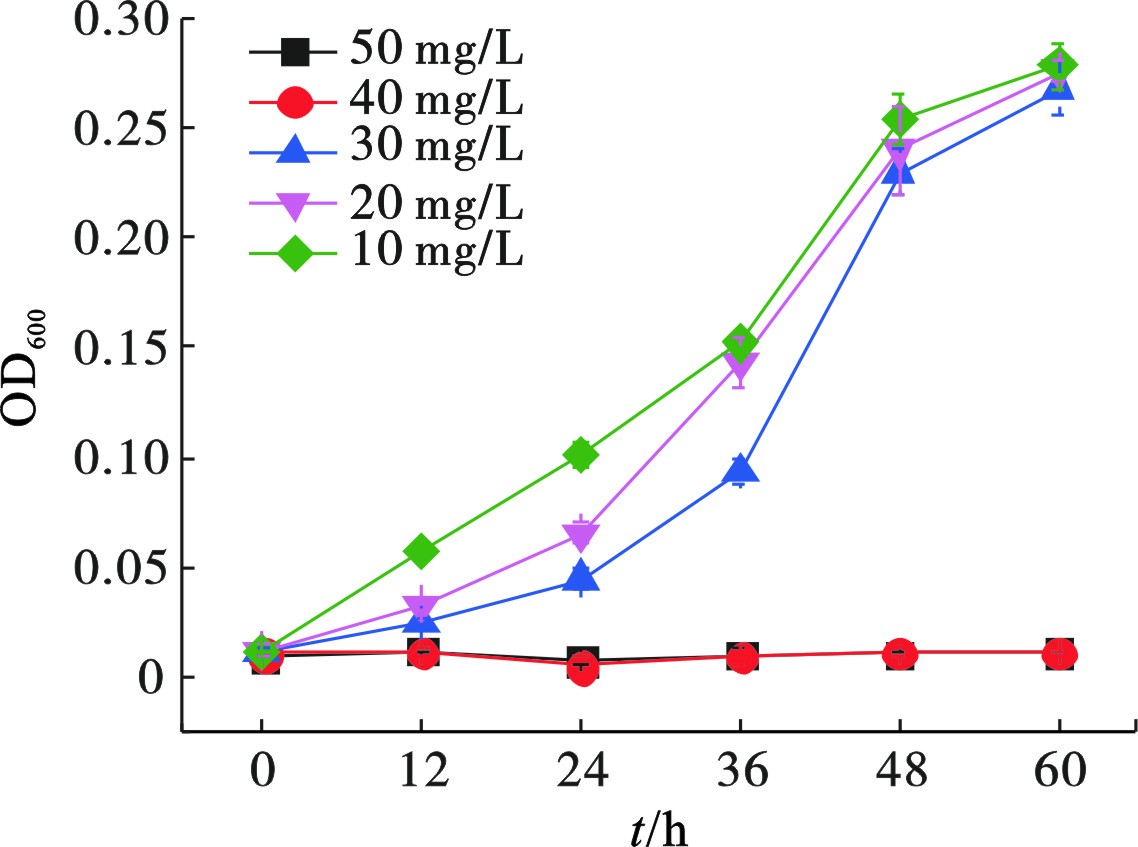
 下载:
下载:
